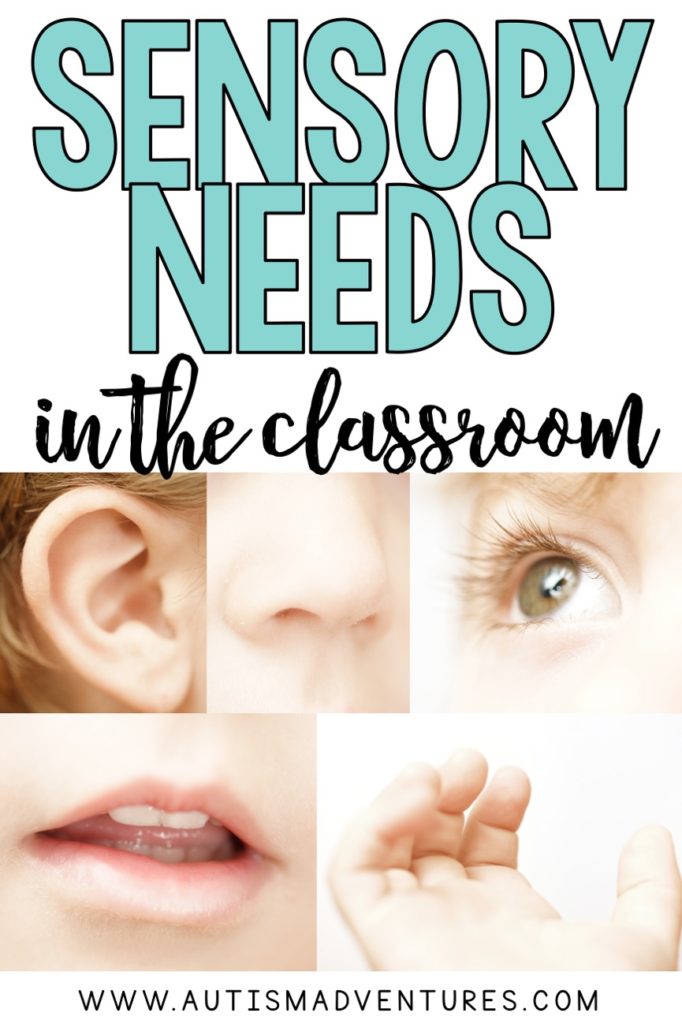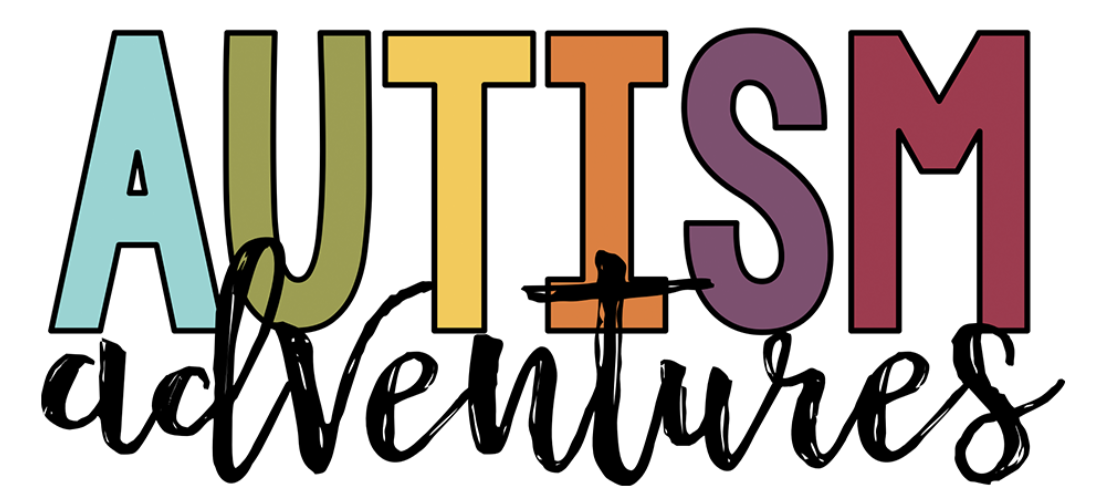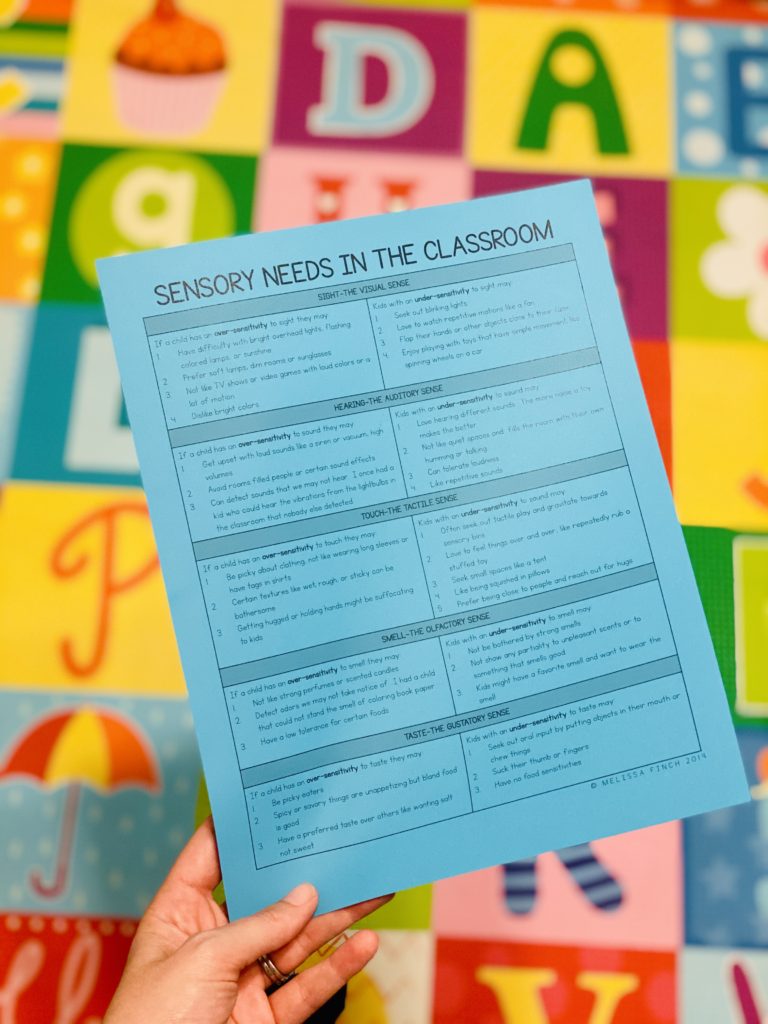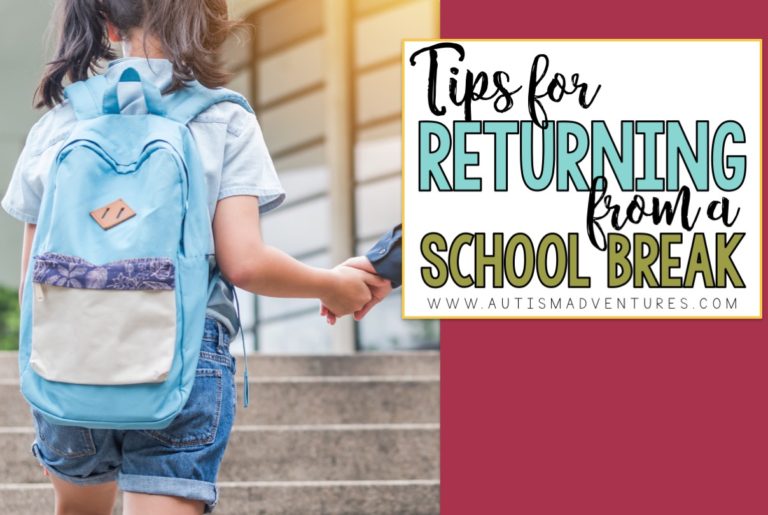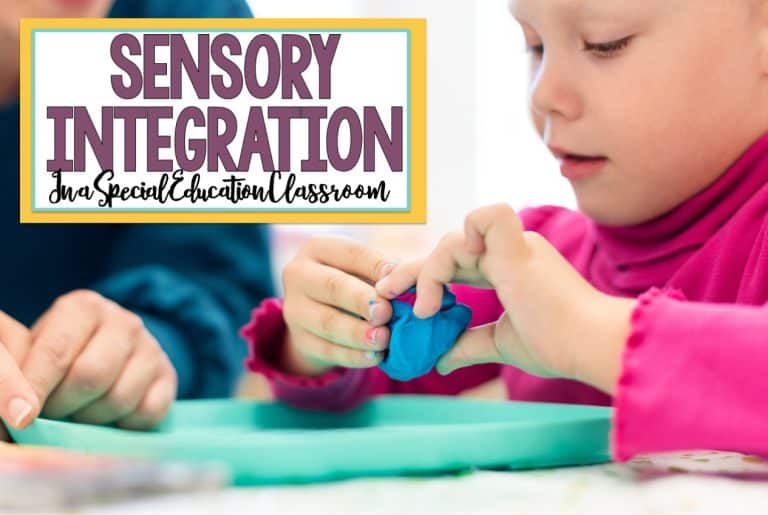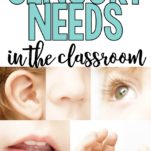Sensory Needs In The Classroom
A common occurrence in my profession is helping a student work through a difficulty that stemmed from a sensory issue. When that happens, it seems like some strategies work while others don’t and a lot of the times it changes daily. Today’s blog post will cover the basics of sensory needs in the classroom.

Sensory Needs in the Classroom
The one thing I find that never changes is the fact that a kid’s senses can make or break their day. It’s our job as educators to help them learn how to regulate their 5 senses so they can have a good day.
Do you find yourself in this position? How can we most effectively support our kids?
I find the best way to answer this question is to go back to basics and simply look at the 5 senses and how they manifest in the kids we work with. I like to call it the 5 senses check-list. You can grab your own checklist for FREE in my Free Resource Library here. Going through each sense and seeing them in action gives me a deeper understanding of each child and better equips us to take care of the sensory needs in the classroom.
In this post, I’m going to discuss what the 5 senses are. I’ll also walk you through a check-list with examples so you can see how your students process sensory input. With this information you will know what to look for in your classroom.
Understanding The 5 Senses
Sight, sound, smell, taste, and touch. These are the tools we use to take in information, process the data, and well, make sense of the world around us.
For most of us sensory processing isn’t a challenge for us. We breeze through our day unaware of our senses. We may take notice of them when we feel cold, or smell something stinky. If my senses feel out of whack I usually know how to fix the problem. Dim the lights or turn up the volume and I’m good to go.
For kids with special needs sight, sound, smell, taste and touch is a different situation. Like us they take in information using their 5 senses, but they may have difficulty processing the information, which in turn affects their thoughts and behavior. It is important to meet their sensory needs in the classroom.
What causes this? There are varying explanations. Typically though kids are either over-sensitive or under-sensitive with their senses. They have difficulty tolerating certain sensations. Sensory input is magnified and they are constantly trying to figure out how they feel in their environment.
Just think about that for a moment! What is it like to be that way?
Let’s dig deeper and assess what our children go through on a daily basis with their 5 senses. Below is a description of the 5 senses along with a check-list of examples of over-sensitivity and under-sensitivity to each one.
Sensory Needs in the Classroom: FREE Checklist
I am going to go over this checklist in detail in the rest of this post. But be sure to grab this freebie in my Free Resource Library so that you are able to print and post this in your classroom. This can be a valuable tool to share with your staff as well to meet all of your sensory needs in the classroom.
Sight-The Visual Sense
We take in a lot of information with our eyes! Seeing can tell us things like what time of day it is, what the weather is. We read words, drive cars, and watch TV using sight. We can recognize people and their emotions by seeing their faces.
If a child has an over-sensitivity to sight they may:
- Have difficulty with bright overhead lights, flashing colored lamps, or sunshine
- Prefer soft lamps, dim rooms or sunglasses
- Not like TV shows or video games with loud colors or a lot of motion
- Dislike bright colors
Kids with an under-sensitivity to sight may:
- Seek out blinking lights
- Love to watch repetitive motions like a fan.
- Flap their hands or other objects close to their face
- Enjoy playing with toys that have simple movement, like spinning wheels on a car
Hearing-The Auditory Sense
Hearing is the door to communication! We can understand what a person is saying. Hearing also gives us information about music and noise. Auditory input can affect our mood, quiet sounds are soothing while loud sounds can be stressful.
If a child has an over-sensitivity to sound they may:
- Get upset with loud sounds like a siren or vacuum, high volumes
- Avoid rooms filled people or certain sound effects
- Can detect sounds that we may not hear. I once had a kid who could hear the vibrations from the lightbulbs in the classroom that nobody else detected.
Kids with an under-sensitivity to sound may:
- Love hearing different sounds. The more noise a toy makes the better
- Not like quiet spaces and fills the room with their own humming or talking
- Can tolerate loudness
- Like repetitive sounds
Touch-The Tactile Sense
Touch informs us of important things! We can determine danger when something is sharp or hot. It can help us feel secure when we feel warm and cozy things.
If a child has an over-sensitivity to touch they may:
- Be picky about clothing, not like wearing long sleeves or have tags in shirts
- Certain textures like wet, rough, or sticky can be bothersome
- Getting hugged or holding hands might be suffocating to kids
Kids with an under-sensitivity to sound may:
- Often seek out tactile play and gravitate towards sensory bins
- Love to feel things over and over, like repeatedly rub a stuffed toy
- Seek small spaces like a tent
- Like being squished in pillows
- Prefer being close to people and reach out for hugs
Smell-The Olfactory Sense
How things smell tells us if something is good or not. Roses smell great, wet gym shoes do not. It too warns us of danger when we smell something burning. Smell can evoke memories, like chocolate chip cookies baking in the oven.
If a child has an over-sensitivity to smell they may:
- Not like strong perfumes or scented candles
- Detect odors we may not take notice of. I had a child that could not stand the smell of coloring book paper
- Have a low tolerance for certain foods
Kids with an under-sensitivity to smell may:
- Not be bothered by strong smells
- Not show any partiality to unpleasant scents or to something that smells good
- Kids might have a favorite smell and want to wear the smell
Taste-The Gustatory Sense
Taste helps us determine what we like or dislike. Certain tastes can evoke memories and feelings, like comfort food helps me feel good.
If a child has an over-sensitivity to taste they may:
- Be picky eaters
- Spicy or savory things are unappetizing but bland food is good
- Have a preferred taste over others like wanting salt not sweet
Kids with an under-sensitivity to tastel may:
- Seek out oral input by putting objects in their mouth or chew things
- Suck their thumb or fingers
- Have no food sensitivities
I hope looking at the 5 senses in action gives you a better picture of your student’s sensory processing. When I understand his or her senses and what makes them tick I am able to effectively support the sensory needs in my classroom. Using this sensory check-list will help you do the same.

Like what you read? Don’t forget it, PIN IT!
